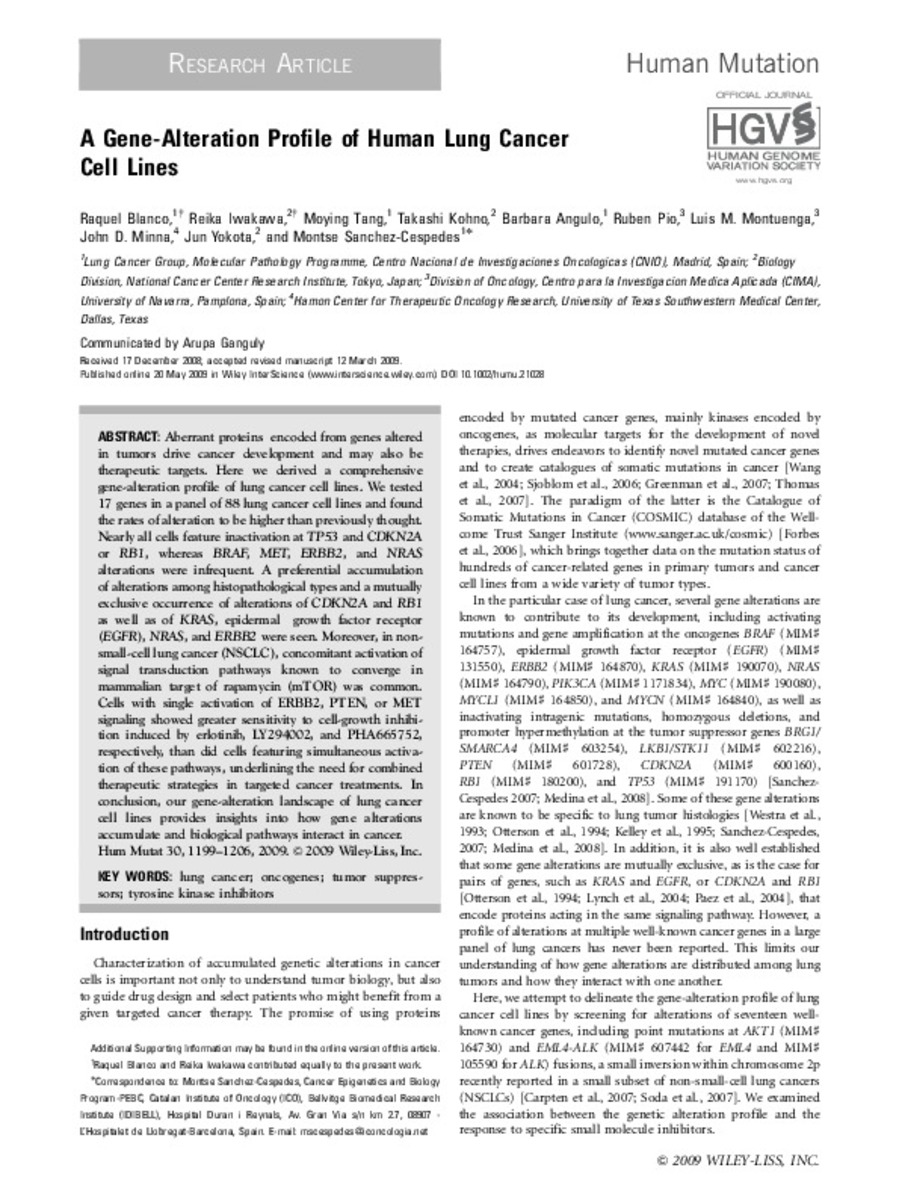Full metadata record
| DC Field | Value | Language |
|---|---|---|
| dc.creator | Blanco, R. (Raquel) | - |
| dc.creator | Iwakawa, R. (R.) | - |
| dc.creator | Tang, M. (Moying) | - |
| dc.creator | Kohno, T. (Takashi) | - |
| dc.creator | Angulo, B. (B.) | - |
| dc.creator | Pio, R. (Rubén) | - |
| dc.creator | Montuenga-Badia, L.M. (Luis M.) | - |
| dc.creator | Minna, J.D. (John D.) | - |
| dc.creator | Yokota, J. (Jun) | - |
| dc.creator | Sanchez-Cespedes, M. (Montserrat) | - |
| dc.date.accessioned | 2010-10-21T07:48:55Z | - |
| dc.date.available | 2010-10-21T07:48:55Z | - |
| dc.date.issued | 2009-03-12 | - |
| dc.identifier.citation | Blanco R, Iwakawa R, Tang M, Kohno T, Angulo B, Pio R, et al. A gene-alteration profile of human lung cancer cell lines. Hum Mutat 2009 Aug;30(8):1199-1206. | es_ES |
| dc.identifier.issn | 1059-7794 | - |
| dc.identifier.uri | https://hdl.handle.net/10171/13568 | - |
| dc.description.abstract | ABSTRACT: Aberrant proteins encoded from genes altered in tumors drive cancer development and may also be therapeutic targets. Here we derived a comprehensive gene-alteration profile of lung cancer cell lines. We tested 17 genes in a panel of 88 lung cancer cell lines and found the rates of alteration to be higher than previously thought. Nearly all cells feature inactivation at TP53 and CDKN2A or RB1, whereas BRAF, MET, ERBB2, and NRAS alterations were infrequent. A preferential accumulation of alterations among histopathological types and a mutually exclusive occurrence of alterations of CDKN2A and RB1 as well as of KRAS, epidermal growth factor receptor (EGFR), NRAS, and ERBB2 were seen. Moreover, in nonsmall- cell lung cancer (NSCLC), concomitant activation of signal transduction pathways known to converge in mammalian target of rapamycin (mTOR) was common. Cells with single activation of ERBB2, PTEN, or MET signaling showed greater sensitivity to cell-growth inhibition induced by erlotinib, LY294002, and PHA665752, respectively, than did cells featuring simultaneous activation of these pathways, underlining the need for combined therapeutic strategies in targeted cancer treatments. In conclusion, our gene-alteration landscape of lung cancer cell lines provides insights into how gene alterations accumulate and biological pathways interact in cancer. Hum Mutat 30, 1199–1206, 2009. & 2009Wiley-Liss, Inc. | es_ES |
| dc.language.iso | eng | es_ES |
| dc.publisher | Human Mutation | es_ES |
| dc.rights | info:eu-repo/semantics/openAccess | es_ES |
| dc.subject | Lung cancer | es_ES |
| dc.subject | Oncogenes | es_ES |
| dc.subject | Tumor suppressors | es_ES |
| dc.subject | Tyrosine kinase inhibitors | es_ES |
| dc.title | A gene-alteration profile of human lung cancer cell lines | es_ES |
| dc.type | info:eu-repo/semantics/article | es_ES |
| dc.identifier.doi | http://dx.doi.org/10.1002/humu.21028 | es_ES |
Files in This Item:
Statistics and impact
Items in Dadun are protected by copyright, with all rights reserved, unless otherwise indicated.






